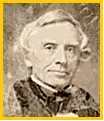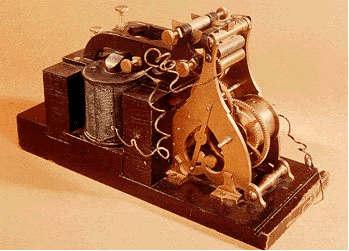Copyright © University of Cambridge. All rights reserved.
'History of Morse' printed from https://nrich.maths.org/
Show menu
 Morse code was invented by an American called Samuel Finley Breese Morse, (1791-1872). He was not only an inventor but also a famous painter.
Morse code was invented by an American called Samuel Finley Breese Morse, (1791-1872). He was not only an inventor but also a famous painter.
Before the invention of the telegraph, most messages that had to be sent over long distances were carried by messengers who memorized them or carried them in writing. These messages could be delivered no faster than the fastest horse. Messages could also be sent visually, using flags and later, mechanical systems called semaphore telegraphs, but these systems required the receiver to be close
enough to see the sender, and could not be used at night.
The telegraph allowed messages to be sent very fast over long distances using electricity. The first commercial telegraph was developed by William Forthergill Cooke and Charles Wheatstone in 1837. They developed a device which could send messages using electrical signals to line up compass needles on a grid containing letters of the alphabet. Then, in 1838, Samuel Morse and his assistant, Alfred
Vail, demonstrated an even more successful telegraph device which sent messages using a special code - Morse code.
Telegraph messages were sent by tapping out the code for each letter in the form of long and short signals. Short signals are referred to as dits (represented as dots). Long signals are referred to as dahs (represented as dashes). The code was converted into electrical impulses and sent over telegraph wires. A telegraph receiver on the other end of the wire converted the impulses back into to
dots and dashes, and decoded the message.
In 1844, Morse demonstrated the telegraph to the United States Congress using a now famous message "What hath God wrought"..

Samuel Morse Telegraph Receiver
Smithsonian National Museum of American History
Morse's original code was not quite the same as the one in use today as it included pauses as well as dahs and dits. However, a conference in Berlin in 1851 established an international version, which is shown below:
| A | . - | N | - . |
| B | - . . . | O | - - - |
| C | - . - . | P | . - - . |
| D | - . . | Q | - - . - |
| E | . | R | . - . |
| F | . . - . | S | . . . |
| G | - - . | T | - |
| H | . . . . | U | . . - |
| I | . . | V | . . . - |
| J | . - - - | W | . - - |
| K | - . - | X | - . . - |
| L | . - . . | Y | - . - - |
| M | - - | Z | - - . . |
The most well-known signal sent using Morse Code is:
. . . - - - . . .
and is the distress signal SOS.
Morse code requires the time between dits and dahs, between letters, and between words to be as accurate as possible.
A Dit takes - 1 unit of time
A Dah takes - 3 units of time
The pause between Dits/Dahs - 1 unit of time
The pause between letters - 3 units of time
The pause between words - 7 units of time
The speed at which a message is sent in Morse code is normally given in words per minute (WPM). The word "Paris" (including the space after it) is used as the length of a standard word. How long does this take? (Answer is given at the end of the article). An experienced Morse code operator can send and receive messages at a rate of 20-30 WPM.
One of Morse's aims was to keep the code as short as possible, which meant the commonest letters should have the shortest codes. Morse came up with a marvellous idea. He went to his local newspaper. In those days printers made their papers by putting together individual letters (type) into a block, then covering the block with ink and pressing paper on the top. The printers kept the letters (type) in cases with each letter kept in a separate compartment. Of course, they had many more of some letters than others because they knew they needed more when they created a page of print. Morse simply counted the number of pieces of type for each letter. He found that there were more e's than any other letter and so he gave 'e' the shortest code, 'dit'. This explains why there appears to be no obvious relationship between alphabetical order and the symbols used.
Answer:
Paris = 50 time units (43 for the letters plus 7 for the space after the word).
You can download a morse code font for windows here.